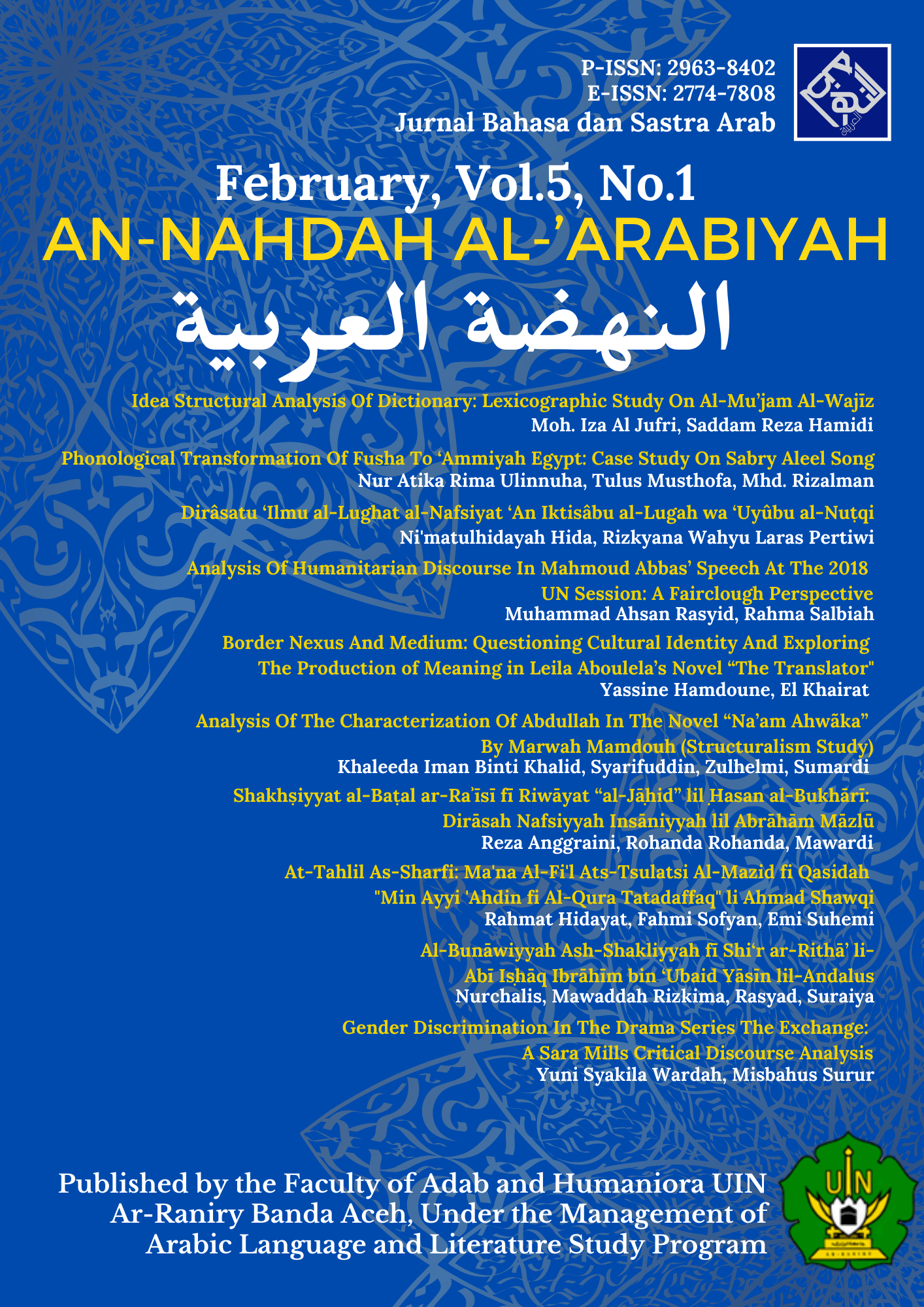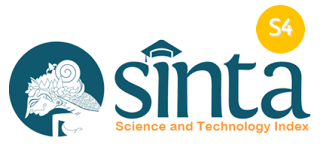Border Nexus And Medium: Questioning Cultural Identity And Exploring The Production of Meaning in Leila Aboulela’s Novel “The Translator"
At-Tarābuṭ al-Ḥudūdī wa al-Wasīṭ: Tasa’ul Ḥawl al-Hawiyyah ath-Thaqāfiyyah wa Istikshāf Intāj al-Ma‘nā fī Riwayat Al-Mutargim li Laylā Abū al-‘Alā
DOI:
https://doi.org/10.22373/nahdah.v5i1.5428Keywords:
borders, identity, medium, postcolonial subjectivity, meaning, transnationAbstract
This paper examines Leila Aboulela’s novel The Translator, focusing on the role of borders in constructing subjectivity and producing meanings within various cultural transformations. It demonstrates that the production of ‘meaning’ requires experiencing different types of borders. This produced ‘meaning’ as an outcome of huge cultural interactions between subjects within borders is significant because borders offer a space where these interactions take place. These interactions exhibit what Stewart Hall calls ‘cultural identification’. The article summons Svend Erik Larsen’s concept ‘medium’ while referring to this space and revealing the intricacies that encapsulate borders as practices. By focusing on symbolic borders, the paper goes throughout Aboulela’s novel of The Translator to map how these borders are manifested and deployed to create new meanings within the different experiences of exile, displacement, and ambivalence. Since the novel is a reflection of the postcolonial era, the paper brings to view Bill Ashcroft’s concept of ‘the transnation’ to underpin the certainty of openness, complexity, potentiality, and multiplicity, which constitute, not only ‘the transnation’, but also Larsen’s understanding of ‘the medium’ and Schimanski and Wolfe’s theory of borders. The conclusion underscores that the medium between physical and symbolic borders is a space where subjectivity goes through different forms of construction to produce new meanings.
تتناول هذه الورقة البحثية رواية The Translator للكاتبة ليلى أبو العلا، مع التركيز على دور الحدود في تشكيل الذات وإنتاج المعاني ضمن التحولات الثقافية المختلفة. وتوضح هذه الورقة أن إنتاج "المعنى" يتطلب تجربة أنواع مختلفة من الحدود. وهذا "المعنى" المُنتَج، كنتيجة للتفاعلات الثقافية الواسعة بين الذوات داخل الحدود، ذو أهمية لأن الحدود توفر فضاءً تحدث فيه هذه التفاعلات. هذه التفاعلات تُظهر ما يسميه ستيوارت هول بـ"التحديد الثقافي". وتستدعي المقالة مفهوم "الوسيط" لسفيند إريك لارسن عند الإشارة إلى هذا الفضاء وكشف التعقيدات التي تجسد الحدود كممارسات. من خلال التركيز على الحدود الرمزية، تتعمق هذه الورقة في رواية The Translator لأبو العلا لرسم خارطة كيفية تجسد هذه الحدود واستخدامها في خلق معانٍ جديدة ضمن تجارب مختلفة من المنفى، والنزوح، والازدواجية. وبما أن الرواية تعكس حقبة ما بعد الاستعمار، تسلط الورقة الضوء على مفهوم "ما بعد الأمة" لبيل أشكروفت لتأكيد يقينية الانفتاح، والتعقيد، والإمكانات، والتعددية، وهي عناصر لا تشكل فقط "ما بعد الأمة"، بل أيضًا فهم لارسن لمفهوم "الوسيط" ونظرية الحدود لشيمانيسكي و وولف. وتؤكد الخاتمة أن "الوسيط" بين الحدود المادية والرمزية هو فضاء تمر فيه الذات بعمليات بناء مختلفة لإنتاج معانٍ جديدة.
Makalah ini mengkaji novel The Translator karya Leila Aboulela dengan menyoroti peran perbatasan dalam membentuk subjektivitas dan menghasilkan makna di tengah berbagai transformasi budaya. Makalah ini menunjukkan bahwa produksi ‘makna’ memerlukan pengalaman terhadap berbagai jenis perbatasan. Makna yang dihasilkan ini, sebagai hasil dari interaksi budaya yang luas antara subjek di dalam perbatasan, menjadi signifikan karena perbatasan menyediakan ruang bagi interaksi tersebut. Interaksi ini mencerminkan apa yang disebut Stuart Hall sebagai ‘identifikasi budaya’. Artikel ini juga mengadopsi konsep ‘medium’ dari Svend Erik Larsen untuk merujuk pada ruang ini serta mengungkap kompleksitas yang melingkupi perbatasan sebagai praktik. Dengan berfokus pada perbatasan simbolik, makalah ini menelusuri novel The Translator karya Aboulela untuk memetakan bagaimana perbatasan tersebut diwujudkan dan digunakan dalam menciptakan makna baru melalui berbagai pengalaman pengasingan, perpindahan, dan ambivalensi. Karena novel ini merefleksikan era pascakolonial, makalah ini juga mengangkat konsep ‘transnation’ dari Bill Ashcroft untuk menegaskan keterbukaan, kompleksitas, potensi, dan multiplikasi, yang tidak hanya membentuk ‘transnation’, tetapi juga pemahaman Larsen tentang ‘medium’ serta teori perbatasan dari Schimanski dan Wolfe. Kesimpulan makalah ini menekankan bahwa medium antara perbatasan fisik dan simbolik merupakan ruang di mana subjektivitas mengalami berbagai bentuk konstruksi untuk menghasilkan makna baru.
References
Abbas, S. (2011). Leila Aboulela, Religion, and the Challenge of the novel. Contemporary Literature, 52(3), 430–461. https://doi.org/10.1353/cli.2011.0034
Aboulela, L. (2006). The translator (1. American ed). Black Cat.
Ashcroft, B. (2016). Utopianism in Postcolonial Literatures (1st ed.). Routledge. https://doi.org/10.4324/9781315642918
---. (2019). Borders, Bordering, and the Transnation. English Academy Review, 36(1), 5–19. https://doi.org/10.1080/10131752.2019.158426
---.(2010). Transnation. In J. Wilson, C. Sandru, & S. Lawson Welsh (Eds.), Rerouting the postcolonial: New directions for the new millennium (pp. 72-85). Routledge.
Ball, A. (2010). ‘Here is Where I am’: Rerouting Diaspora Experience in Leila Aboulela’s Recent Novels. In J. Wilson, et al. (Eds.), Rerouting the Postcolonial: New Directions for the New Millennium (pp. 118-127). Routledge.
Castillo, A. D. (2007). Borders, Identities, Objects. In J. Schimanski & S. Wolfe (Eds.),
Border poetics de-limited (1st ed., pp. 115-148). Wehrhahn.
Derrida, J. (2021). What is a relevant translation? In L. Venuti (Ed.), The translation studies reader (4th ed., pp. 373-396). Routledge.
Guattari, F., & Deleuze, G. (2005). A Thousand Plateaus: Capitalism and Schizophrenia (B. Massumi, Trans.). University of Minnesota Press.
Hall, S., & Du Gay, P. (Eds.). (1996). Questions of cultural identity. Sage.
---. (1996). Who Needs ‘Identity’? In S. Hall & P. Du Gay (Eds.), Questions of cultural identity (pp. 1-17). Sage.
Hassan, W. S. (2008). Leila Aboulela and the ideology of Muslim Immigrant fiction.
NOVEL a Forum on Fiction, 41(2–3), 298–318. https://doi.org/10.1215/ddnov.041020298
Jannah, F. R. (2024). Penerjemahan Video Dakwah Syekh Nabil Al-Awadi: Analisis Kesalahan Fonetik Artikulatoris-Auditoris: The Translation of Sheikh Nabil Al-Awadi's Da'wah Video: An Analysis of Articulatory-Auditory Phonetic Errors. An-Nahdah Al-'Arabiyah, 4(2), 155-193.
Larsen, E. E. (2007). Boundaries Ontology Methods, Analysis. In J. Schimanski & S. Wolfe (Eds.), Border poetics de-limited (1. Aufl) (pp. 79-114). Wehrhahn.
Saunders, T., & Rosello, M. (2017). Ecology. In J. Schimanski & S. Wolfe (Eds.), Border aesthetics: Concepts and intersections (pp. 25-49). Berghahn.
Schimanski, J., & Wolfe, S. (Eds.). (2007). Border poetics de-limited (1. Aufl). Wehrhahn.
---. (2017). Border aesthetics: Concepts and intersections. Berghahn.
Wilson, J., Sandru, C., & Lawson Welsh, S. (Eds.). (2010). Rerouting the postcolonial: New directions for the new millennium. Routledge.
Zulhelmi, A., Ahmad, M. Y., Fajri, A., Shaliha, C. A. A., & Sofyan, Z. (2024). The Impact of Philology Practicum for Arabic Language and Literature Students on The Preservation of Ancient Manuscripts at Dayah Teungku Chiek Awe Geutah: Dampak Praktikum Filologi Mahasiswa Prodi Bahasa dan Sastra Arab Terhadap Pelestarian Naskah Kuno Di Dayah Teungku Chiek Awe Geutah. Indonesian Journal of Islamic History and Culture, 5(2), 125-131.






1.png)

